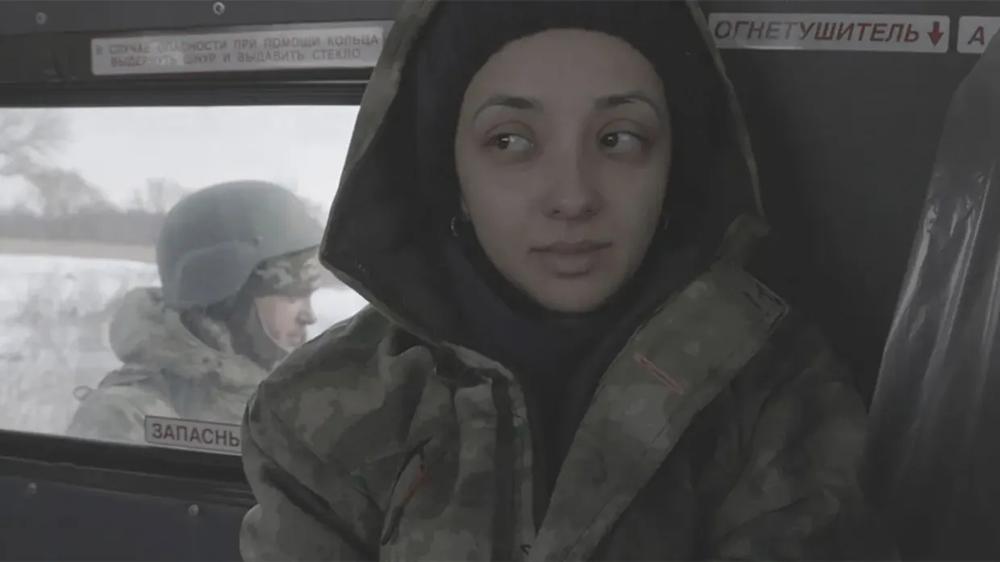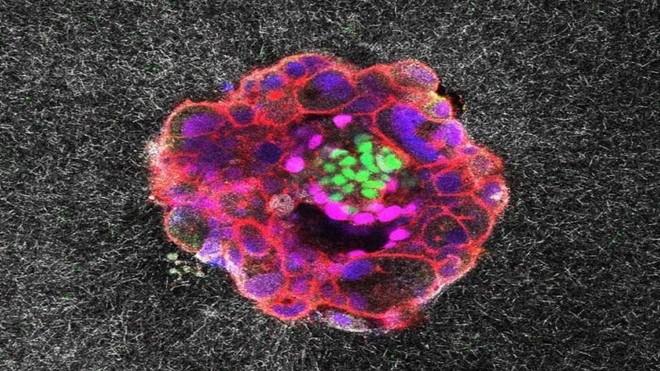“The majority of Ukrainian people hate Russians — but why, I just can’t understand," a young Russian infantry conscript who goes by the callsign Cartoon declares in the documentary “Russians at War.”
Such moments come to define “Russians at War,” which Russian-Canadian filmmaker Anastasia Trofimova shot while embedded with Russian troops who invaded Ukraine, throughout its more than two-hour runtime — passing, seemingly innocent statements that accumulate into a larger ideological contour. The film caused an uproar during its festival circuit run last year, with critics accusing it of being a vessel for pro-Russian propaganda.
The filmmakers behind “Russians at War” have dismissed the backlash as censorship, claiming that most of their critics hadn’t even seen the film. When the Kyiv Independent requested a press copy last year to review it, the filmmakers declined, citing concerns over “bias.” Now, with the film available on pay-per-view, they are encouraging audiences to watch and “judge for themselves.” So, we did.
War is presented as a matter of personal perspective, rather than a clear-cut crisis measured against international law and state sovereignty.
At its core, “Russians at War” is a troubling film, marked by a deliberate ambiguity that functions as an ideological tool and shapes how viewers look at Russia’s full-scale war against Ukraine. From the very start, Trofimova sets this tone in her voiceover: “This is the Luhansk People’s Republic. Or occupied eastern Ukraine. Or the new Russian territories. It depends on who you ask.” War is presented as a matter of personal perspective, rather than a clear-cut crisis measured against international law and state sovereignty.
“Russians at War” was shot over seven months, during which Trofimova — by her own repeated account — entered Russian-occupied territory without press accreditation or clearance from the Defense Ministry or security services. She reminds the viewer of this several times throughout the film. Independent Russian media outlets rightfully voiced skepticism about this claim when the documentary began its screenings on the festival circuit, given that it has predominantly been members of Russian state-controlled media and war bloggers who have had access to the Russian side of the front.
Trofimova’s claim appears even more doubtful when set against the tragic fate of Ukrainian journalist Viktoriia Roshchyna, who entered Russian-occupied southeastern Ukraine via Russian territory in July 2023 to document wartime atrocities firsthand. While the full circumstances surrounding Roshchyna’s trip remain unclear, we know that she was eventually singled out by Russian authorities, arrested, tortured, and killed in prison — to conceal the extent of her torture, her body was even returned missing some organs.
“Russians at War” asks us to accept more than just Trofimova’s unprecedented access to the front as a stroke of luck, though. Our entrypoint into this world is not a bombastic, foul-mouthed Kremlin loyalist but a soft-spoken, charismatic Ukrainian named Illia fighting on the side of Russia. Through him, the audience is introduced to a version of events that frames the full-scale war’s origins in 2014, when Russia invaded Ukraine’s Donetsk and Luhansk oblasts, as Ukraine’s “civil war.” Illia recounts how the violence in his native Donetsk forced him to “part ways with Ukraine,” ultimately leading him to relocate his family to Russia.
The focus on Illia, among the other soldiers we are introduced to, is deliberate. Trofimova attempts to foster a sense of trust between him and the viewer, encouraging them to take his claims at face value — like how those who built the Soviet Union are “rolling in their graves” over the current state of Ukrainian–Russian relations, or that nationalists in western Ukraine “destroyed all the heritage that united us (Russians and Ukrainians).” By framing these misleading statements through the lens of one man’s personal loss, the film normalizes them, and ultimately endeavors to establish a sense of legitimacy to such claims, which a more informed viewer would recognize as propaganda repeatedly used by Russia to “justify” its war.
As Illia laments the loss of “brotherly nations,” his supply unit, along with Trofimova, traverses a derelict Soviet-era military installation in occupied Luhansk Oblast. The following scenes unfold slowly, letting the audience take in lingering images of Soviet relics: dusty posters declaring “We are for peace!", worn portraits of Bolshevik leader Vladimir Lenin, and half-collapsed buildings scarred by decades of neglect and war. The decay of the site, set against these symbols of Soviet ideology, creates a layered visual argument that “endorses” Illia’s words.
Through this montage, the viewer is compelled to see Trofimova’s lens as sympathetic to Illia’s perspective, as if the ruins echo his story of shared history and fraternal bonds. The silent imagery does more than set the scene — it carries a haunting, almost nostalgic resonance that complicates the film’s observational stance, leaving the question of whether the camera is simply recording reality or subtly endorsing a particular political vision.
Trofimova rarely challenges the Russian soldiers on contentious topics. Some might acknowledge this as a matter of personal safety, yet she offers no voiceover narration in the film to counterbalance them later on. This lack of engagement creates a conspicuous moral void. For instance, when she asks the young infantryman Cartoon whether he believes reports that the Russian army is committing war crimes, he refuses even to entertain the possibility. The conversation lapses into uneasy silence, a moment of tension left unresolved.
As of this publication, Ukraine’s General Prosecutor’s Office has documented 182,186 war crimes committed by the Russian military since the start of the full-scale war.
The filmmakers defend their approach by calling “Russians at War” an observational portrait and encouraging other filmmakers to engage in a dialogue of perspectives with their own work. Yet this argument strains credibility amid the ongoing full-scale war when public perception of it plays an undeniable role in the debates surrounding military aid that can save countless lives. At best, the approach shows a serious lapse in judgment; at worst, it seems a deliberate effort to obscure the war’s true human cost and political stakes to the world.
When the Russian soldiers speak of wanting “peace,” the implication is clear: this peace, as the film presents it, can be achieved only through Russia’s victory.
Later in the film, when visiting the cemetery where some of her “acquaintances” — as she calls the Russian soldiers — are buried, Trofimova tells the viewer that these men were “not superhuman or evil.” She makes this argument throughout the film by repeatedly presenting them as compassionate figures, offering her own counter narrative to the documented reports of widespread atrocities committed by the Russian military in Ukraine.
Russian combat medics are shown risking their lives to recover both the wounded and the dead. They bring humanitarian aid to Ukrainian villagers living dangerously close to the front lines, places volunteers are too afraid to visit. When Trofimova accompanies them on a humanitarian mission, she meets an elderly Ukrainian woman who says, “Of course, we are all for Russia,” and expresses her fear that the Ukrainian military’s advance would “kill us all.”
People like the tearful old woman and Illia do exist in Ukraine — we cannot pretend otherwise. Yet they remain an ever-shrinking minority, and their presence should not be taken as representative of Ukraine’s east. Moreover, such individuals are neither unique to Ukraine nor indicative of the nation’s long-term trajectory — misinformed, indoctrinated people can be found anywhere in the world.
The real issue arises when their perspectives are shown in isolation, stripped of historical and political context — particularly, the violent legacy of Soviet Russification policies in Ukraine, which shaped cultural, linguistic, and regional identities over decades. As such, these fringe views carry heavy weight in the film’s messaging. The Russian side’s quest to restore former “relations” is presented as fulfilling one's legacy, rather than a crime against Ukrainian people, who just want to finally be free of Russia.
When the Russian soldiers speak of wanting “peace,” the implication is clear: this peace, as the film presents it, can be achieved only through Russia’s victory. The viewer is compelled by Trofimova to see the war as tragic because it has torn Ukrainians and Russians apart, sidestepping the far darker and more consequential reality: Russia’s true objective has long been to forcibly reintegrate Ukraine into its orbit, stitching it back together like Frankenstein’s monster.
Amid this moral ambiguity, scenes of Russian soldiers — numb from alcohol or struggling with post-traumatic stress after returning from the zero line — debating why they are fighting in Ukraine, or breaking down in tears, invite a complex emotional response. The audience is asked to empathize with individual suffering while the broader context — the organized, state-driven aggression against Ukraine — remains largely unexamined. This approach obscures accountability, offering compassion for the soldiers without confronting the machinery of war that enables, directs, and benefits from their actions.
Still, despite the Russian soldiers’ repeated questioning of whether those in power are artificially prolonging the war and who ultimately benefits, moments of stark clarity cut through the ambiguity, revealing what is at stake if Ukraine fails to resist.
When a drone operator who goes by the call sign Cap is asked why he fights, he answers bluntly, “It’s either me or them.” His friend Cartoon adds with chilling certainty, “People, they’re all the same — it doesn’t matter what nation, or what religion, we’re all people! And then there are Nazis.” He goes on to say there are “a lot” of Nazis in Ukraine, echoing Russian President Vladimir Putin’s speech on the first day of the full-scale war, when he declared the Russian military’s mission was to “demilitarize and denazify Ukraine.”
These words, somehow meant to justify Russia’s war, have spread over more than three years like a cancer, eroding people’s minds and leading them to see Ukrainians not as citizens of a sovereign nation with the right to live in peace, but as targets to be killed. Words carry power – when Trofimova amplifies these words and their power goes unchecked, more innocent people just end up being killed.

 ESPN’s streaming launch brings a TikTok-like feed and AI commentary
ESPN’s streaming launch brings a TikTok-like feed and AI commentary